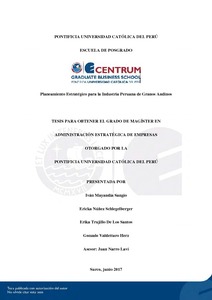| dc.contributor.advisor | Narro Lavi, Juan Pedro Rodolfo | |
| dc.contributor.author | Mayandía Sangio, Iván | es_ES |
| dc.contributor.author | Núñez Schlegelberger, Ericka | es_ES |
| dc.contributor.author | Trujillo De Los Santos, Erika | es_ES |
| dc.contributor.author | Valdettaro Herz, Gonzalo | es_ES |
| dc.date.accessioned | 2017-07-14T15:31:07Z | |
| dc.date.available | 2017-07-14T15:31:07Z | |
| dc.date.created | 2017 | |
| dc.date.issued | 2017-07-14 | |
| dc.identifier.uri | http://hdl.handle.net/20.500.12404/9000 | |
| dc.description.abstract | Los granos andinos son originarios de la sierra peruana y boliviana y han sido
consumidos desde la época de los Incas. Desde aquella época fueron siempre considerados
como parte esencial de su alimentación debido a la gran cantidad de nutrientes y minerales
que contienen. En la actualidad, el Perú es el principal productor y exportador de granos
andinos del mundo, superando en los últimos años a Bolivia, quien venía siendo el principal
exportador. En los últimos años, la producción de granos andinos, en especial la de la
Quinua, ha tenido un fuerte incremento, debido al mayor consumo local e internacional de
este grano. El Perú ha venido realizando una adecuada promoción de este grano, recalcando
su alto potencial alimenticio y nutritivo. La alta demanda, durante varios años, generó
incrementos en los precios de venta y a su vez una mayor cantidad de hectáreas cosechadas a
lo largo del todo el Perú. En los últimos años, desde el 2015 los precios han tendido a
decrecer y luego han empezado a estabilizarse en el tiempo.
La presente tesis, mostrará un plan estratégico para desarrollar la industria de los
granos andinos para los próximos diez años, y se trabajará especialmente la de la quinua y
kiwicha, debido a que estos granos representan casi el 95% del total de granos andinos
producido. La estrategia se centrará en fomentar la producción de granos orgánicos en las
regiones de Cusco, Puno y Ayacucho, tres de las regiones con mayor cantidad de hectáreas
cosechadas y donde se dan las mejores condiciones climáticas y geográficas para estos
cultivos. La producción deberá ir acompañada de un uso eficiente de recursos y tecnología
para mejorar los rendimientos de las tierras. Finalmente, se deberá fomentar el añadirle el
mayor valor agregado posible a esos productos para poder llegar a los mercados locales y
externos directamente al consumidor y lograr retener localmente el mayor margen posible | es_ES |
| dc.description.abstract | The andean grains are native from the mountain range of Peru and Bolivia and have
been consumed by the Inca Empire. Since that time, the andean grains have been considered
as an essential part of human's diet, because of its nutrients and minerals. Nowadays, Peru is
the world’s main producer and exporter of andean grains, beating Bolivia, who was the main
exporter in the past years. During the last years the andean grain production, specially the
quinoa production, has increased substantially, because of a growth in the local and
international markets. Peru has been investing in marketing, in order to get the potential
markets to know the benefits of the products. The greater demand caused an increase of the
price and the hectares harvested in the country. It was just in the last two year when the
prices began to decrease and stabilize.
The present thesis will show a strategic planning to develop the andean grains
industry for the next ten years, working specially with quinoa and kiwicha, because these
grains represent more than 95% of total andean grains production. The strategy will be
centered in promoting the organic production of these grains, especially in Cusco, Puno and
Ayacucho regions. These regions have the mayor quantity of cultivated hectares and the best
geography and climate for these grains. The production will have to be complemented with
high resource use efficiency and new technology in order to increase the terrain performance.
Finally it will be necessary to increase the added value to all the products sold to the local and
external markets, in order to maintain locally the most part of the earnings in the value chain | es_ES |
| dc.language.iso | spa | es_ES |
| dc.publisher | Pontificia Universidad Católica del Perú | es_ES |
| dc.rights | info:eu-repo/semantics/openAccess | es_ES |
| dc.rights.uri | http://creativecommons.org/licenses/by-nc-nd/2.5/pe/ | * |
| dc.subject | Planificación estratégica | es_ES |
| dc.title | Planeamiento estratégico para la industria peruana de granos andinos | es_ES |
| dc.type | info:eu-repo/semantics/masterThesis | es_ES |
| thesis.degree.name | Maestro en Administración Estratégica de Empresas | es_ES |
| thesis.degree.level | Maestría | es_ES |
| thesis.degree.grantor | Pontificia Universidad Católica del Perú. CENTRUM | es_ES |
| thesis.degree.discipline | Administración Estratégica de Empresas | es_ES |
| renati.discipline | 413307 | es_ES |
| renati.level | https://purl.org/pe-repo/renati/level#maestro | es_ES |
| renati.type | https://purl.org/pe-repo/renati/type#tesis | es_ES |
| dc.publisher.country | PE | es_ES |
| dc.subject.ocde | https://purl.org/pe-repo/ocde/ford#5.02.04 | es_ES |






